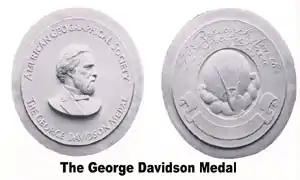
The George Davidson Medal is awarded by the American Geographical Society for the "exceptional achievement in research for exploration in the Pacific Ocean or the lands bordering therein".[1] In 1946, the American Geographical Society received a bequest of $5000 from his daughter Ellinor Campbell Davidson to establish the medal and a research fund to honor her father. The medal was designed by American sculptor Paul Manship in 1951.[2]
History
George Davidson was a geographer and scientist noted for his work with the U.S. government exploring and charting the western United States and Alaska. Davidson was a geodist for the U.S. Coast and Geodetic Survey, working heavily in the Pacific waters. He later became a professor at the University of California.[2] In 1907, he published The Discovery of San Francisco Bay.
Recipients
Source: American Geographical Society
- 1952: George Babcock Cressey
- 1972: F. Raymond Fosberg
- 1974: Joseph Spencer
- 1975: Shinzo Kiuchi
- 1988: Hiroshi Ishida
- 1999: Hou Renzhi
- 2001: David Stoddart
- 2020: Dawn Wright
See also
References
- ↑ "George Davidson Medal". American Geographical Society. Archived from the original on 2014-02-25. Retrieved 2010-06-17.
- 1 2 Wright, John Kirtland 'The Years of Henry Grinnell', Geography in the Making: The American Geographical Society 1851-1951 (1952) pp. 14–70. — [George Grady Press]
Further reading
- "The World Its Oyster". The New York Times. 1952-06-01.
- "Geographers Sift Point Four Factors". The Christian Science Monitor. 1952-08-09.
- "Five Geographers to Receive Medals". The New York Times. 1952-07-21.